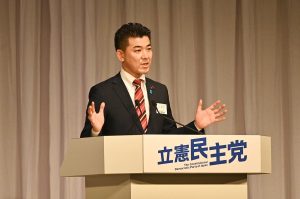Japan’s main opposition party, the Constitutional Democratic Party of Japan (CDP), elected a new leader last week in an effort to rebuild the party after a humiliating election loss in the lower house election in October that saw the governing Liberal Democratic Party (LDP) regain power for the fourth consecutive general election since 2012.
Izumi Kenta, 47, became the new face of the CDP. He faces a rocky path ahead in unifying the party and rebuilding the CDP’s image and its policy agenda by next summer’s upper house election. The lower house election exposed a series of unresolved issues – namely the CDP’s negative public image and the lack of organizational strength in regional Japan.
The CDP, which was founded in 2017, was largely driven by the personal clout of founder Edano Yukio, who resigned following the disastrous election result. Edano was the face of the CDP; his resignation has shifted the balance of power among Japan’s opposition parties and has put the party at a crossroads.
The appointment of Izumi, who is relatively young, signals a generational shift and an effort to build the CDP as a trusted political party. Izumi is not a household name in Japan, and this may help rebrand and set a new direction for the CDP. He also aims to win over a new generation of constituents who have been voting increasingly in favor of the LDP.
After winning the CDP runoff election, Izumi stated that he hoped to ensure the party operates as a “party for the people” that does not tolerate absurdities in politics and “brightens the future of Japan.” He also added that there was no such thing as being “too young” in politics.
The lower house election highlighted that the Japanese public is growing tired of the opposition’s repetitive tactic of confronting and criticizing the ruling LDP. The role of the opposition is to keep the government in check, but the CDP has failed to deliver easy-to-understand counter proposals, innovative policies, or proposals to improve the way politics is conducted in Japan.
The CDP’s goal of improving its popularity and bringing about a change of government cannot be achieved by simply changing personnel. Public support for the Kishida administration appears to be on the way up, with an approval rating of 63 percent compared to 55 percent in early October when it first came into power. By comparison, the CDP is contending with a drop in its overall approval rating from 11 percent in November to 7 percent this month.
Despite the challenges, a Yomiuri Shimbun poll found that 70 percent CDP supporters had “high expectations” for the new leader.
The CDP needs to prepare a compelling policy vision and broaden the scope of their policies beyond a choice between economic growth or redistribution. Kishida’s economic policies have featured wealth distribution and narrowing income disparity as a way to achieve long term economic growth. The CDP will need to develop standout policy objectives in order to differentiate themselves from the LDP.
Izumi stated that he will prioritize “people-centric” policies as opposed to criticizing the LDP for the sake of criticism and will base its policy debate on principles of “right” and “wrong” and “constructive discussions.”
The CDP’s policy on gender equality can also be leveraged to create a new political trend. Izumi made headlines for enlisting an equal number of women and men in the CDP’s 12-member executive committee, including the three also-rans from the party’s leadership election. In doing so, Izumi dismantle the male-dominated board of his predecessor Edano. The party also aims to reach gender parity on the CDP’s list of candidates for the upper house election.
Meanwhile, the CDP will embark on building a viable electoral force and political capital by aligning itself with regional grassroot bodies and political networks.
Since the formation of the CDP, its founder Edano took steps to strengthen ties with other opposition parties. But the party’s relationship with the Japan Communist Party (JCP) sharply divided public opinion. The CDP’s tactic to unify opposition candidates in single seat electoral districts with the JCP was framed as essential to defeating the governing LDP and junior Komeito coalition, but it may have turned off voters who distrust the JCP.
In the end, the CDP won only 91 seats in the lower elections – a loss of 14 seats from the previous election held four years ago. The left-leaning alliance is believed to have led to a loss of support among regular CDP voters. The same Yomiuri Shimbun opinion poll cited above found that 63 percent of respondents disagree that the party should continue its alliance with JCP.
Izumi has said that the strategy of coordinating candidates across single member constituencies will remain key to winning seats. But the CDP’s closeness with the JCP will remain a controversial strategy up for debate.
The CDP’s influence as the number one opposition party took a hit with the unexpected rise of the conservative Nippon Ishin no Kai (Japan Restoration Party), which tripled its seats at the most recent lower house election. There are concerns that the CDP’s political decline could trigger a split, as seen in 2017 when the Democratic Party split to form the current CDP.

































